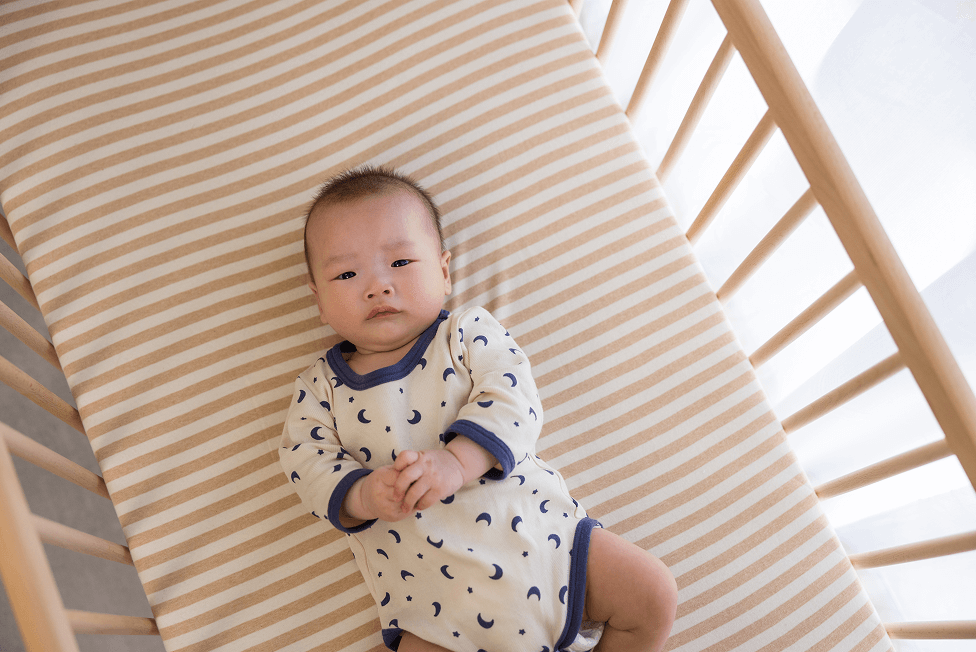Your baby will spend a lot of time sleeping. It is important to create a safe space for every sleep.
Sudden Unexpected Infant Death (SUID) is a term that refers to all causes of sudden infant death during sleep. This includes accidental deaths caused by suffocation or strangulation and Sudden Infant Death Syndrome (SIDS) when the cause is not known.
Place Baby on Their Back for Every Sleep
Infants that sleep on their back can breathe better and are less likely to choke or suffocate (stop breathing) than infants who sleep on their tummy or side.

Safe Sleep Environment for Every Sleep
Providing a safe sleep space for your baby for every sleep is the best way to keep them safe and comfortable.
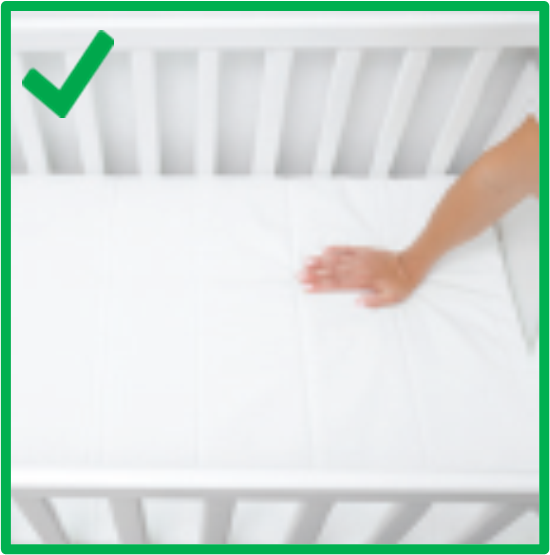
A crib, cradle or bassinet are safe sleep spaces. They can be purchased new or used but should meet Health Canada standards.
The mattress must be:
- Firm
- Flat
- The right size for crib, cradle or bassinet
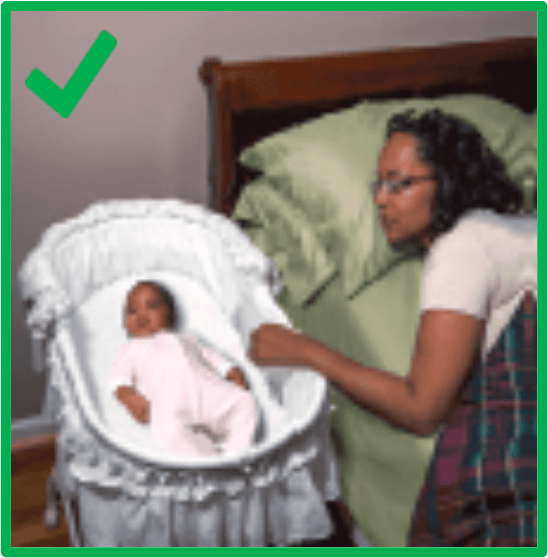
Sleeping in the same room as your baby helps you attend to their needs and to bond with your baby.
- Place crib in your room
- The safest place for a baby to sleep is in a crib, cradle or bassinet in your room for the first six months, or ideally, for the first year.
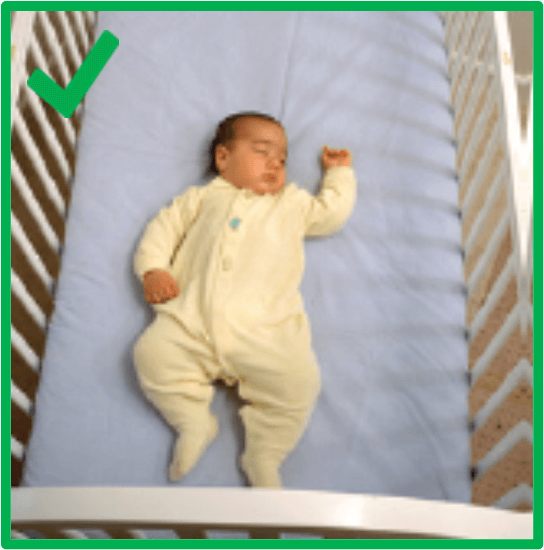
Avoid overheating
- Dress baby in sleeper
- Use a sleep sack or wearable blanket for extra warmth
- Keep room temperature comfortable, not hot
- Hats can make most babies too hot
- See Safer Swaddling Tips below
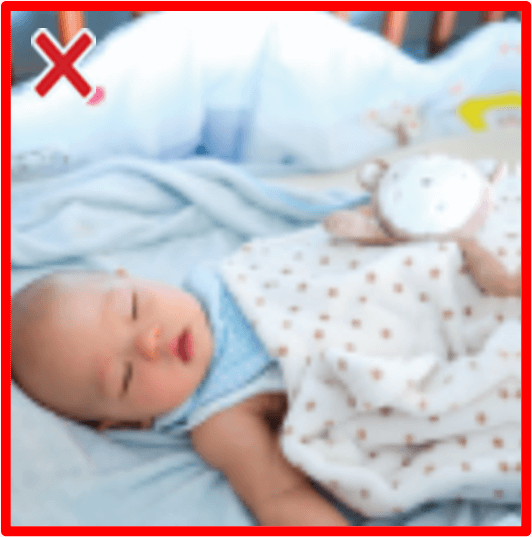
While it may seem comforting to include other items in the crib, it is best for baby to sleep without:
- Pillows or bumper pads
- Bottles
- Stuffed animals or toys
- Sleep postioners
- Loose blankets or quilts
Also, baby should not have anything around their neck for sleeping such as jewelry, teething necklaces, bibs or soother strings
Other Sleep Safe Options
The safest place for a baby to sleep is in a crib, cradle or bassinet. Playpens usually do not meet Canadian safe sleep recommendations. Bassinets that are sold with some playpens are a safer, lower cost choice.
Parents may use other options below for a temporary sleep space. Talk to your health-care provider to make sure it is as safe as possible.
All sleep spaces should be kept:
- On the floor to avoid the risk of falling
- Away from baseboard or portable heaters, fireplaces, wood stoves, ovens and other sources of heat
- Away from pets. Pets may wish to snuggle and can accidentally smother the baby.
Ask a knowledge keeper about safe use of cradleboards and moss bags
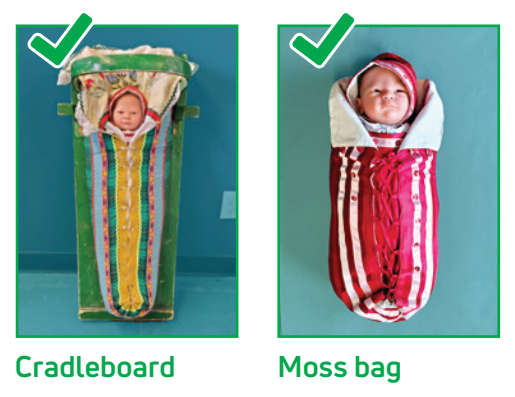
Check out this video on safe sleep from The First Nations Health and Social Secretariat of Manitoba.
If you do not have a crib, cradle or bassinet, you can make a safe sleep space for your baby with some very simple household items such as a drawer (pulled out from the dresser), a basket, a box or a bin (without a lid). Your baby can sleep comfortably and safely in these homemade sleep spaces.

For tips on making these temporary sleep spaces and making a mattress, call your health-care provider, your public health office or visit our other pages on parentinginmanitoba.ca
Unsafe sleep spaces
Remember your ABCs!
Baby should sleep:
Alone
On their Back
In a Crib (cradle, bassinet, safe sleep space)
It is important for baby to always sleep alone, on their back and in a safe sleep space with a firm flat mattress and sides that will prevent the baby from rolling/falling out.
Baby should sleep alone. Bed-sharing in the same sleep space such as a bed has risks. Adults, other children or pets can accidentally hurt the baby or make it hard for the baby to breathe. If you decide bed-sharing is best for you and your baby, see safer bed-sharing below.
Babies should sleep on their backs. Sleeping on their side or tummy can make it hard for your baby to breathe. Surfaces that are sloped (not flat) may cause the baby to roll into an unsafe sleep position. Baby’s head can also slump forward, making it hard for the baby to breathe.
Soft surfaces do not support the baby to lay flat and in the best position for breathing. Soft materials, such as blankets could cover the baby’s face, making it hard for them to breathe.
Surfaces like couches or an adult bed are risky as they may be too soft for baby to be in a good sleeping position and the baby may roll off and fall, become trapped between the mattress and cushions, or the cushions or material may make it difficult for baby to breathe.
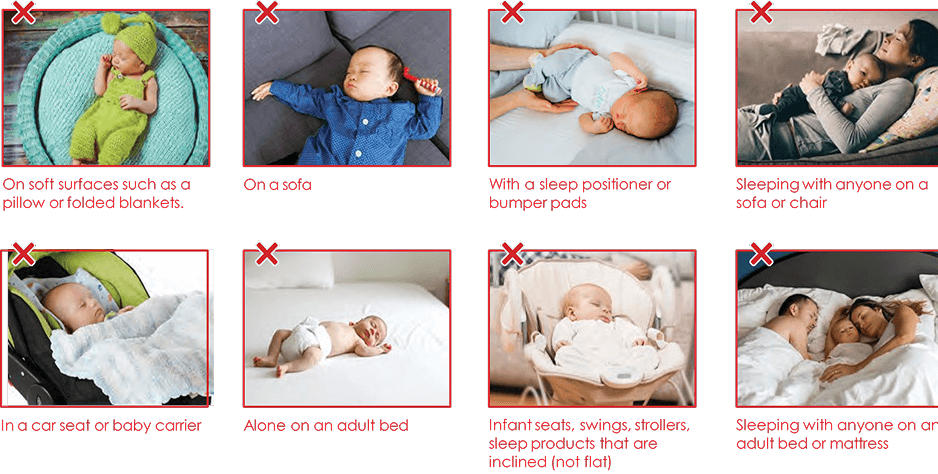
Safer Bed-Sharing
Babies are safest in their own sleep space like a crib, cradle or bassinet.
If you do not have a crib, cradle or bassinet, contact your health care provider or public health office who will work with you to find a solution. You can also make a safe sleep space out of common household items (see above).
Some families choose to have their baby sleep in their bed with them.
Use this checklist to bed-share more safely.
- Baby sleeps on back directly on a firm mattress. Co-sleepers, car seats, or infant seats are not safe sleep spaces.
- Parent’s long hair is tied up and away from baby’s face.
- Bedding and sheets are pulled low enough so that there is no risk of blankets or sheets covering the baby’s face.
- Bed is away from the wall and other furniture so baby can’t get trapped between the bed and a firm surface.
- Baby is not swaddled. Use a sleep sack if needed.
- Baby is placed on the side of one parent. Both parents know that the baby is in the bed. Baby is never in the middle of two adults or next to other children or pets.
- No soft bedding such as comforters and pillows near baby
- Room temperature is cool and comfortable so that baby doesn’t overheat
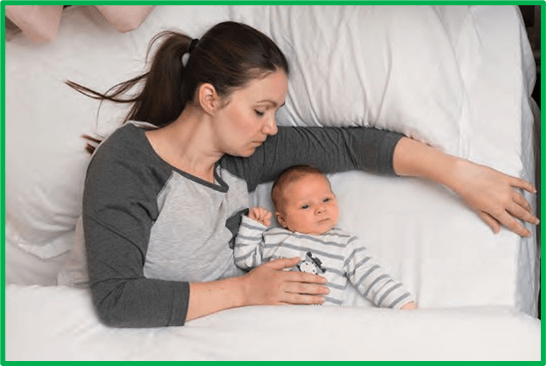
When Not to Bed-share
If your baby:
- Was born at less than 37 weeks (pre-mature, or born early)
- Was small at birth (weighed less than 2.5 kilograms or 5.5 pounds)
- Is under four months of age, when the risk of suffocation (not breathing) and sudden unexpected infant death is highest
If you or your partner:
- Smoke, if there is any smoking in the home or if you smoked during pregnancy
- Are overly tired or are sick
- Have been drinking alcohol
- Have taken any medications or drugs that make you feel sleepy
- Are obese
Sleep Sacks and Sleepwear
There are many types of swaddles, blankets and sleep sacks on the market. Choose the right size for baby and always follow the manufacturer’s instructions.
Not all are safe.
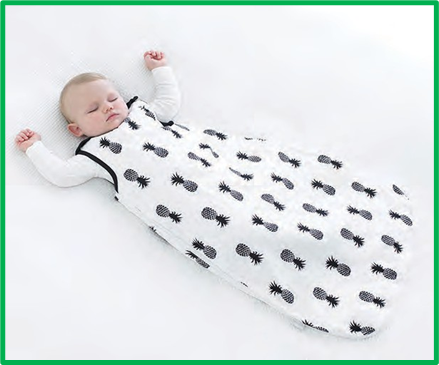
Choose safer ones that:
- Are snug around the upper body so that baby is unable to wiggle out
- Are not tight around baby’s chest. You should be able to get two fingers between baby’s chest and the sack
- Are loose around the hips. Your baby’s legs should bend and move comfortably.
- Have no choking hazards like snaps, buttons
- Meet children’s sleepwear flammability standards.
Remember, outdoor wear is not designed for sleep. Day clothes may have zippers, hoods and strings that are also not appropriate for sleeping or meet Health Canada’s flammability standards.
Most sleepwear in Canada is safe. However, be cautious of clothing purchased in other countries, vintage clothing, novelty wear (like costumes) and homemade/crafted sleepwear as the material may not meet Canada’s fabric sleepwear standards.
Safer Swaddling
Most babies are warm enough in just a sleeper, or with a wearable blanket or swaddler if they need extra warmth. Swaddled babies can become overheated. The swaddle can also become loose and cover the baby’s mouth and nose, making it hard to breathe.
If you choose to swaddle your baby, follow these tips to help keep them safer.
When choosing a swaddle wrap, look for:
- Light, breathable fabric such as cotton with a loose weave. Avoid heavy blankets.
- No drawstrings, ribbons, cords or tight elastic.
- No buttons, snaps or decorations.
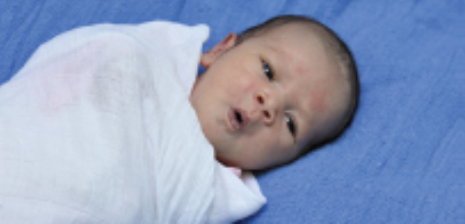
Choose the right swaddling technique for your baby’s age:
- For younger babies (birth until three months old), wrap the arms in the swaddle with baby’s elbows bent and hands close to the chin.
- For older babies (about three to six months old and babies who can roll), leave their arms free.
How to safely swaddle a baby
- Spread the wrap out with one corner folded. Lay baby on wrap.
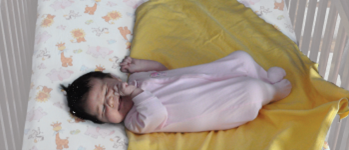
- Bring baby’s hands together over their chest. Bring one side of the wrap over their arms and tuck under baby.
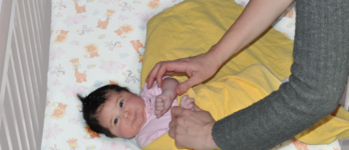
- Fold the bottom of the wrap up, leaving room for baby’s feet to move.
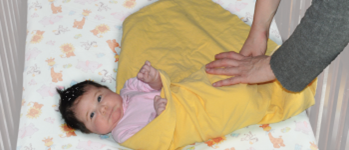
- Bring the second side of the wrap across baby and tuck the end behind baby.
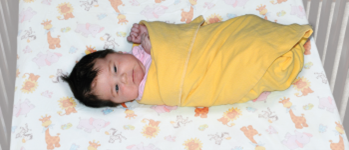
Follow these tips to keep baby safer
- Keep baby on their back
- Don’t let baby get too hot
- Make sure that the blanket or swaddle doesn’t cover their face
- Keep swaddle loose at the hips and legs. Babies who do not have their legs free to bend and kick can suffer abnormal hip development.
- When baby can roll over, stop swaddling or wrap baby with arms free.
Other practices to protect against SIDS
Breastfeeding/Chestfeeding Protects Baby
Breastfeeding/chestfeeding lowers the risk of SIDS. Breastmilk/chestmilk boosts infants’ immune systems, supports their brain development and helps them wake up from sleep easier.
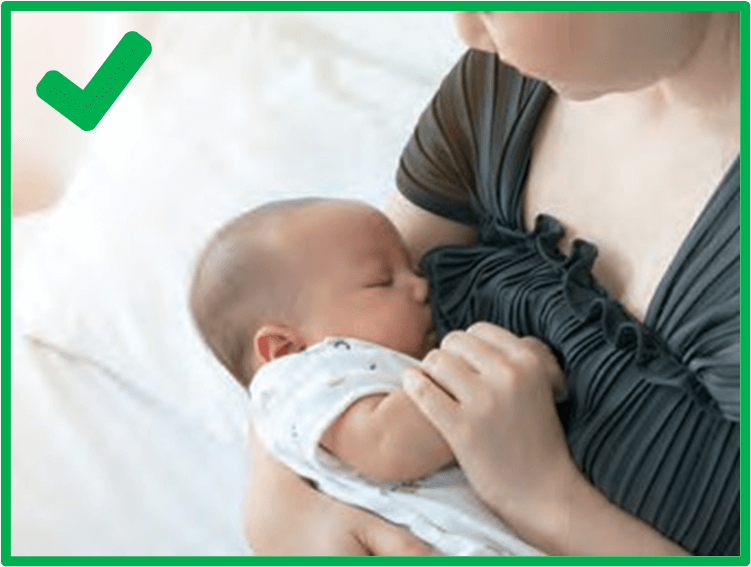
Once breastfeeding/chestfeeding is established, consider using a pacifier (soother), which may reduce the risk of SIDS.
While not everyone can or wants to breastfeed/chestfeed you can still protect your baby if you are bottle-feeding by following all of the other tips in this article.
When bottle feeding always hold your baby and the bottle to prevent your baby from choking. No matter how you feed your baby, always place your baby back to sleep in a crib, cradle or bassinet.
Keep baby smoke-free before and after birth
Smoke exposure increases the risk of SIDS. Tobacco smoke contains several toxic chemicals that can damage the cells of the body. It can affect infant brain and lung development. This can affect how an infant breathes and may increase the risk of SIDS.
It is safest for a home to be smoke free. If you smoke, do it outside, wash your hands and change your clothes before holding your baby. It is safest to avoid using alcohol, tobacco, vaping products, cannabis and other drugs while trying to become pregnant, during pregnancy and while breastfeeding/chestfeeding.
For support with quitting or cutting down visit Smoker’s helpline or call them at 1-877-513-5333, Tobacco Has No Place Here, NUQUITS and/or talk to your health-care provider
For help with other substances call Manitoba Addictions Helpline – 1-855-662-6605
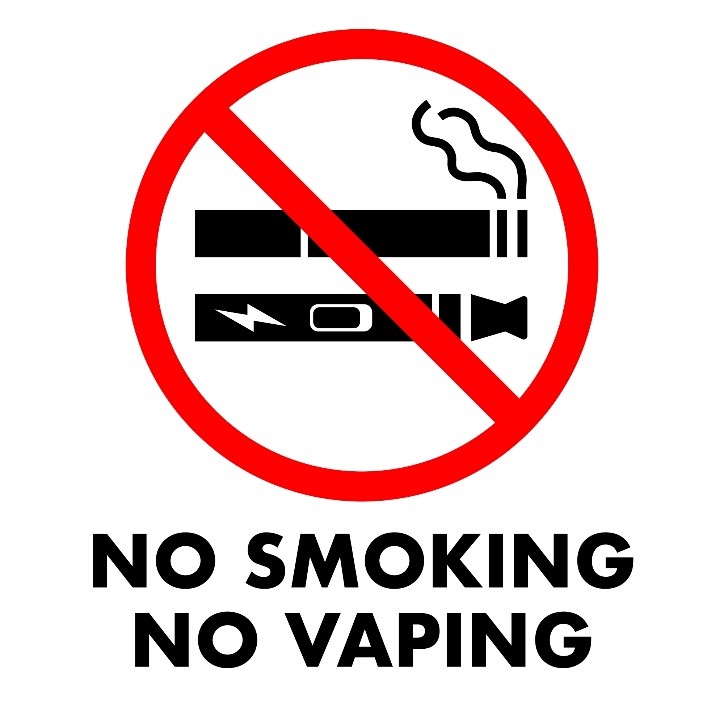
For more information on safe sleep, bed-sharing, swaddling, sleep sacks and other child health and safety topics, contact your primary care provider, your public health office or see our other articles on parentinginmanitoba.ca.
Check Health Canada’s website for recalls on baby equipment including sleepwear, cribs, cradles and car seats. Visit healthycanadians.gc.ca.

